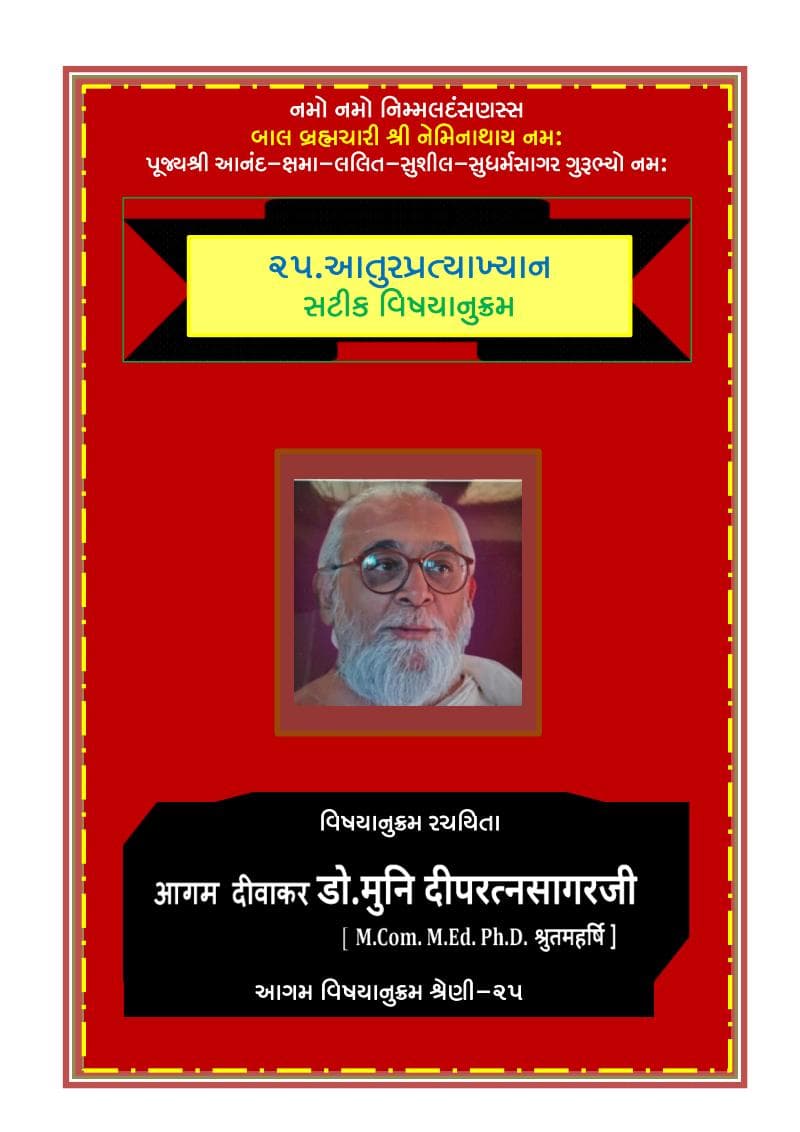25 Aaturpratyakhyan Satik Vishayanukram
Added to library: September 1, 2025

Summary
Here's a comprehensive summary of the Jain text "25 Aaturpratyakhyan Satik Vishayanukram" based on the provided title and catalog link:
Book Title: 25 Aaturpratyakhyan Satik Vishayanukram Author(s): Dipratnasagar, Deepratnasagar Publisher: Dipratnasagar, Deepratnasagar Catalog Link: https://jainqq.org/explore/033925/1
Summary:
"25 Aaturpratyakhyan Satik Vishayanukram" is a Jain text authored by Dipratnasagar and Deepratnasagar, published by the same individuals/entity. The title itself provides a strong indication of its content:
- "25": This signifies that the book likely contains twenty-five distinct sections, principles, or practices.
- "Aaturpratyakhyan" (आतुर्प्रत्याख्यान): This is a core concept in Jainism, referring to "renunciation or fasting undertaken in a state of illness or distress." It's a specific type of vow or practice undertaken when one is suffering from physical ailments. The term can also broadly refer to the renunciation of worldly desires and actions driven by afflictions.
- "Satik" (सतिक): This indicates that the text is commented upon or includes an explanation/commentary. Therefore, the book likely presents the twenty-five Aaturpratyakhyan practices along with their detailed explanations, elaborations, or commentaries by the author(s).
- "Vishayanukram" (विषयानुक्रम): This means "subject-wise index" or "table of contents." This suggests that the book is structured in a systematic manner, with a clear listing of the topics covered, likely corresponding to the twenty-five Aaturpratyakhyan principles.
Overall, "25 Aaturpratyakhyan Satik Vishayanukram" is a Jain text that systematically presents and elaborates upon twenty-five principles or practices related to "Aaturpratyakhyan." This concept is central to Jain spiritual discipline, particularly for managing one's mental and physical state during times of illness or suffering. The commentary provided by the authors aims to offer a deeper understanding and guidance on how to engage with these practices.
Key Themes and Potential Content:
Based on the title, the book is likely to cover:
- The philosophical and ethical underpinnings of Aaturpratyakhyan: Why is it important to renounce desires and actions when ill?
- The twenty-five specific practices or vows: What are these individual renunciations or fasts? They might range from dietary restrictions to mental detachment from worldly concerns.
- The benefits of practicing Aaturpratyakhyan: How does it aid in spiritual progress, purification of the soul, and ultimately, liberation (moksha)?
- The proper methodology for undertaking Aaturpratyakhyan: Guidance on how to observe these practices correctly.
- Examples or case studies: The commentary might include instances of how these practices have been observed by ascetics or pious individuals.
- The role of Aaturpratyakhyan in the path of a Jain monk/nun or a layperson: How it fits into the broader framework of Jain spiritual life.
In essence, the book serves as a detailed guide and manual for understanding and implementing the significant practice of Aaturpratyakhyan within the Jain tradition, offering a structured approach with in-depth explanations.